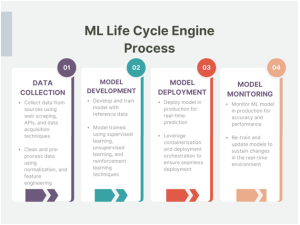Machine learning (ML) is a rapidly growing field with the potential to revolutionize many industries. However, successfully managing the ML life cycle is crucial for organizations striving to leverage the full potential of their data-driven initiatives.
ML life cycle engines are software platforms that automate the tasks involved in deploying, monitoring, and managing ML models. They can help businesses improve the accuracy and performance of their ML models, reduce the risk of operational errors, and increase the ROI from their ML initiatives.
In this blog post, we will discuss the features, benefits, and challenges of ML life cycle engines.
Understanding the ML life cycle
ML life cycle engine encompasses various stages that include data collection and preprocessing, model deployment, model monitoring, and model management.
Data Collection and Pre-Processing
The first step in the ML life cycle involves gathering relevant and high-quality data from a variety of sources such as web scraping, APIs, data acquisition, customer transactions, or sensor data. Once the data is collected, it must be cleaned and preprocessed using techniques like data cleaning, handling missing values, normalization, and feature engineering to ensure that it is in a format that the ML model can understand.
Model Development
The next step in the ML life cycle is to develop the ML model. The model is trained on the data that was collected and preprocessed in the previous stages. The model is trained using a variety of techniques, such as supervised learning, unsupervised learning, and reinforcement learning. The goal of model development is to create a model that can make accurate predictions.
Model Deployment
This stage involves deploying the trained ML model into production for prediction on real-time data. Depending on the requirements and infrastructure, models can be deployed either on-premises or in the cloud. Containerization and deployment orchestration are important considerations to ensure seamless deployment and scalability. Effective model deployment is essential for leveraging the predictive capabilities of ML models in real-world scenarios.
Model Monitoring
Once the ML model is deployed, it is important to monitor its performance by versioning and tracking the accuracy of the model’s predictions, identifying any areas where the model is performing poorly, and retraining them to improve its performance. Documentation and knowledge sharing play a vital role in efficient model management, enabling collaboration and knowledge transfer across teams.

Benefits of ML Life Cycle Engine
Leveraging an ML life cycle engine enables organizations to achieve higher ROI by optimizing resource utilization, reducing time-to-deployment, and maximizing the value extracted from ML-driven initiatives. It enhances efficiency and accuracy with automated workflows and model-tracking capabilities.
- Improved Efficiency and Accuracy in Managing ML Projects: An ML life cycle engine provides a centralized platform to automate and streamline ML processes, such as data preprocessing, model training, deployment, and monitoring. This results in improved efficiency, and reduced human error, ensuring consistency and accuracy throughout the ML life cycle, leading to reliable and reproducible results.
- Streamlined Version Control and Model Tracking: ML life cycle engines streamline version control, and model tracking capabilities, compare different versions, and roll back to previous iterations if needed. by providing a centralized repository for storing ML data, models, and code. This ensures transparency, facilitates collaboration and simplifies model auditing.
- Increased ROI from machine learning initiatives: One of the primary goals of implementing an ML life cycle framework is to maximize the return on investment (ROI) and increase productivity with machine learning initiatives. By enabling faster model deployment, and accelerated time-to-insights, it allows businesses to capitalize on ML-driven opportunities swiftly.
How to choose the right ML Engine?
Selecting the appropriate framework among the variety of available ML engines in the market is a critical decision that can significantly impact the success of your projects. When choosing an ML life cycle engine,
Consider your specific needs
Consider factors such as project complexity, team size, data volume, scalability needs, and integration capabilities. Determine whether you need specialized features or if a more general-purpose engine will suffice.
Sit with your team and categorize the kind of ML projects you want to work on, the data you possess, your team’s technical expertise, available computing resources for your projects, etc.
By understanding your unique needs, you can narrow down the options and focus on ML life cycle engines that align with your goals.
Compare features and pricing
Once you have identified your requirements, compare the features such as automated data collection and preprocessing, scalable model training, seamless deployment, and robust model monitoring capabilities. Consider the ease of use, integration with existing tools and frameworks, and the level of customization available.
Additionally, make sure to analyze the models based on
- Ease of use
- Flexibility
- Pricing
- Budget
By carefully comparing features and pricing, you can identify the ML life cycle engine that provides the best value for your organization.

